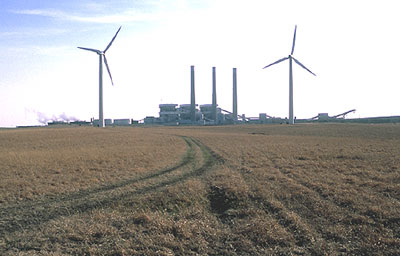| Kansas Geological Survey | Winter
2003 |
Vol.
9.1 |
|
Energy Council Issues Report
CONTENTS Energy Council–page 1
|
As Kansas changes from a net energy producer to a net energy consumer, energy is more important to the state than ever. That’s one of the reasons that former Governor Bill Graves established the State Energy Resources Coordination Council. The 13-member council, appointed in September 2002, is headed by Lee Allison, director of the Kansas Geological Survey. The council is to compile information about the availability, production,
and use of energy in Kansas; develop an initial comprehensive state energy
plan; and advise the Governor and Legislature about energy trends in production
and consumption and any tax or revenue implications. The council came up with an initial set of recommendations during its
first three meetings, recommendations that were delivered to the Governor
and Legislature in mid-January. According to Allison, the council focused
on actions that have a realistic chance of implementation, given the state’s
financial situation. The recommendations include continued auditing of
the energy performance of state buildings and updating energy efficiency
standards for construction in Kansas. The council also recommended establishing a task force to look at the
state’s electrical transmission network, especially in light of
the recent interest in wind energy; creating a working group to identify
the energy research needs in Kansas; and establishing an annual energy
conference to bring together researchers, decision-makers, industry representatives,
and the public to discuss energy issues. The council examined trends in Kansas energy production and use, developing
forecasts of production and consumption. Perhaps most importantly, the
council adopted the Kansas Energy Information Network as its official
web site (http://www.kansasenergy.org/sercc.htm), a one-stop shop for
information about state energy issues. The council’s initial report
to the Governor and Legislature is available at the website, along with
an interactive map that allows users to pull together energy-related data. “In just a few months, we have developed and reported on a great
deal of energy information,” said Allison. “The council’s
initial reports will serve as a basis for moving Kansas toward energy
self-sufficiency.” That information is especially timely. For decades, Kansas was among
the top oil and gas producing states in the nation. While production has
declined from many of the state’s oil and gas fields, especially
from the huge Hugoton natural gas area in southwestern Kansas, the state’s
power plants have imported increasing amounts of coal, mainly from western
states such as Wyoming, to generate electricity. Such developments mean
less tax and business revenue, along with fewer jobs in the oil patch. But the situation isn’t all bleak. Wind energy is of growing interest
in the state, with the construction of a wind farm in Gray County and
the possible location of several others in the Flint Hills (creating a
new set of environmental issues related to wind farms) and other parts
of Kansas. Large blocks of land have been leased and drilled in eastern
Kansas in the exploration for coalbed methane, natural gas that can be
removed from coal. Even the state’s older oil fields hold the promise
of production, depending on prices and new technologies, such as the use
of carbon dioxide to strip oil that was left behind by conventional methods. The council will continue its efforts over the coming year, refining its energy data and developing a statewide energy plan. “We are laying the groundwork for a long-term comprehensive addressing of the energy situation,” said Allison. |
|
Jeffrey Energy Center, Pottawatomie County, Kansas, with wind turbines in foreground. |
 |
| Online March 10, 2003 Comments to: lbrosius@kgs.ku.edu Kansas Geological Survey URL:http://www.kgs.ku.edu/Publications/GeoRecord/2003/vol9.1/Page1.html |